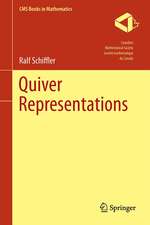Geometry and Algebra in Ancient Civilizations
Autor Bartel L. van der Waerdenen Limba Engleză Paperback – 8 oct 2011
Preț: 559.44 lei
Preț vechi: 699.30 lei
-20% Nou
Puncte Express: 839
Preț estimativ în valută:
107.05€ • 114.47$ • 89.26£
107.05€ • 114.47$ • 89.26£
Carte tipărită la comandă
Livrare economică 14-21 aprilie
Preluare comenzi: 021 569.72.76
Specificații
ISBN-13: 9783642617812
ISBN-10: 3642617816
Pagini: 244
Ilustrații: XII, 226 p.
Dimensiuni: 156 x 244 x 17 mm
Greutate: 0.4 kg
Ediția:Softcover reprint of the original 1st ed. 1983
Editura: Springer Berlin, Heidelberg
Colecția Springer
Locul publicării:Berlin, Heidelberg, Germany
ISBN-10: 3642617816
Pagini: 244
Ilustrații: XII, 226 p.
Dimensiuni: 156 x 244 x 17 mm
Greutate: 0.4 kg
Ediția:Softcover reprint of the original 1st ed. 1983
Editura: Springer Berlin, Heidelberg
Colecția Springer
Locul publicării:Berlin, Heidelberg, Germany
Public țintă
ResearchCuprins
1. Pythagorean Triangles.- A. Written Sources.- Fundamental Notions.- The Text Plimpton 322.- A Chinese Method.- Methods Ascribed to Pythagoras and Plato.- Pythagorean Triples in India.- The Hypothesis of a Common Origin.- Geometry and Ritual in Greece and India.- Pythagoras and the Ox.- B. Archaeological Evidence.- Prehistoric Ages.- Radiocarbon Dating.- Megalithic Monuments in Western Europe.- Pythagorean Triples in Megalithic Monuments.- Megalith Architecture in Egypt.- The Ritual Use of Pythagorean Triangles in India.- C. On Proofs, and on the Origin of Mathematics.- Geometrical Proofs.- Euclid’s Proof.- Naber’s Proof.- Astronomical Applications of the Theorem of Pythagoras?.- Why Pythagorean Triangles?.- The Origin of Mathematics.- 2. Chinese and Babylonian Mathematics.- A. Chinese Mathematics.- The Chinese “Nine Chapters”.- The Euclidean Algorithm.- Areas of Plane Figures.- Volumes of Solids.- The Moscow Papyrus.- Similarities Between Ancient Civilizations.- Square Roots and Cube Roots.- Sets of Linear Equations.- Problems on Right-Angled Triangles.- The Broken Bamboo.- Two Geometrical Problems.- Parallel Lines in Triangles.- B. Babylonian Mathematics.- A Babylonian Problem Text.- Quadratic Equations in Babylonian Texts.- The Method of Elimination.- The “Sum and Difference” Method.- C. General Conclusions.- Chinese and Babylonian Algebra Compared.- The Historical Development.- 3. Greek Algebra.- What is Algebra?.- The Role of Geometry in Elementary Algebra.- Three Kinds of Algebra.- On Units of Length, Area, and Volume.- Greek “Geometric Algebra”.- Euclid’s Second Book.- The Application of Areas.- Three Types of Quadratic Equations.- Another Concordance Between the Babylonians and Euclid.- An Application of II, 10 to Sides and Diagonals.- Thalesand Pythagoras.- The Geometrization of Algebra.- The Theory of Proportions.- Geometric Algebra in the “Konika” of Apollonios.- The Sum of a Geometrical Progression.- Sums of Squares and Cubes.- 4. Diophantos and his Predecessors.- A. The Work of Diophantos.- Diophantos’ Algebraic Symbolism.- Determinate and Indeterminate Problems.- From Book A.- From Book B.- The Method of Double Equality.- From Book ?.- From Book 4.- From Book 5.- From Book 7.- From Book ?.- From Book E.- B. The Michigan Papyrus 620.- C. Indeterminate Equations in the Heronic Collections.- 5. Diophantine Equations.- A. Linear Diophantine Equations.- Aryabhata’s Method.- Linear Diophantine Equations in Chinese Mathematics.- The Chinese Remainder Problem.- Astronomical Applications of the Pulverizer.- Aryabhata’s Two Systems.- Brahmagupta’s System.- The Motion of the Apogees and Nodes.- The Motion of the Planets.- The Influence of Hellenistic Ideas.- B. PelVs Equation.- The Equation x2= 2y2±l.- Periodicity in the Euclidean Algorithm.- Reciprocal Subtraction.- The Equations x2= 3y2 +1 and x2= 3y2— 2.- Archimedes’ Upper and Lower Limits for w3.- Continued Fractions.- The Equation x2= Dy2± 1 for Non-squareD.- Brahmagupta’s Method.- The Cyclic Method.- Comparison Between Greek and Hindu Methods.- C. Pythagorean Triples.- 6. Popular Mathematics.- A. General Character of Popular Mathematics.- B. Babylonian, Egyptian and Early Greek Problems.- Two Babylonian Problems.- Egyptian Problems.- The “Bloom of Thymaridas”.- C. Greek Arithmetical Epigrams.- D. Mathematical Papyri from Hellenistic Egypt.- Calculations with Fractions.- Problems on Pieces of Cloth.- Problems on Right-Angled Triangles.- Approximation of Square Roots.- Two More Problems of Babylonian Type.- E. Squaring the Circleand Circling the Square.- An Ancient Egyptian Rule for Squaring the Circle.- Circling the Square as a Ritual Problem.- An Egyptian Problem.- Area of the Circumscribed Circle of a Triangle.- Area of the Circumscribed Circle of a Square.- Three Problems Concerning the Circle Segment in a Babylonian Text.- Shen Kua on the Arc of a Circle Segment.- F. Heron of Alexandria.- The Date of Heron.- Heron’s Commentary to Euclid.- Heron’s Metrika.- Circles and Circle Segments.- Apollonios’ Rapid Method.- Volumes of Solids.- Approximating a Cube Root.- G. The Mishnat ha-Middot.- 7. Liu Hui and Aryabhata.- A. The Geometry of Liu Hui.- The “Classic of the Island in the Sea”.- First Problem: The Island in the Sea.- Second Problem: Height of a Tree.- Third Problem: Square Town.- The Evaluation of ?.- The Volume of a Pyramid.- Liu Hui and Euclid.- Liu Hui on the Volume of a Sphere.- B. The Mathematics of Aryabhata.- Area and Circumference of a Circle.- Aryabhata’s Table of Sines.- On the Origin of Aryabhata’s Trigonometry.- Apollonios and Aryabhata as Astronomers.- On Gnomons and Shadows.- Square Roots and Cube Roots.- Arithmetical Progressions and Quadratic Equations.















